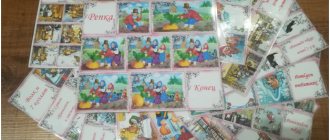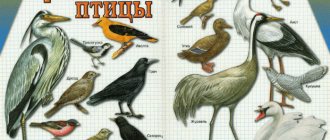How does memory work in preschool children?
Before moving on to a description of the principle of using mnemonic tables, it is necessary to dwell on the features of memory development in preschoolers. First of all, it is important to say that in the majority of preschool children, figurative memory predominates (this can be visual, as well as auditory, olfactory and other images of perception). At the same time, children remember information mainly mechanically, involuntarily. That is, the child remembers what interests him or what makes a strong impression on him. Therefore, an unusual and bright form of presentation is very important. With the development of speech, children's ability to perceive words increases: a preschooler can memorize poetry, he easily remembers the plots of fairy tales and cartoons. However, according to psychological and pedagogical research, it is much easier for children to reproduce information if in the process they can rely on visual diagrams. In older preschool age, the child begins to form voluntary memory. With the development of the ability to self-control, the baby learns to independently remember information that may be useful to him. It is visual aids (diagrams, sketches, notes) that allow children to better remember the necessary material.
Preschool children have the most developed figurative memory, therefore, in order for the child to better remember any information, it is necessary to use various visual aids, including mnemonic tables.
Mnemonics based on fairy tales: a technique for preschool teachers
Memory training for children is also carried out by teachers in preschool educational institutions. In this case, reference diagrams and mnemonic tables are selected from the mnemonics. Education begins at one or two years of age, since during this period the baby already knows some fairy tales and can tell them. However, he often confuses characters from different fairy tales. Mnemonic tables will help you remember the main characters of a given fairy tale.
Mnemonic table based on the fairy tale “Kolobok”
Illustrations of fairy tale characters are placed in the table cells. The fairy tale “Kolobok” is especially convenient for teaching, since it has many characters.
Additional Information! For the youngest students, four cells or no more than nine are enough.
During the learning process, the teacher draws images in the cells of the table with the children. This is very exciting for children, and later they can begin to come up with such tables and images themselves.
Didactic games for older children
Memory improves due to the constant encoding of information into pictures and vice versa, and is also reinforced verbally.
What are mnemonic tables?
Mnemonic tables are diagrams consisting of sequentially arranged image-symbols in which the content of texts (fairy tales, poems, etc.) is encrypted. Thanks to them, the child can perceive information not only auditorily, but also through visual images. The formation of additional associations facilitates the memorization process and helps to reproduce learned material. Most often, mnemonic tables are used for memorizing poems, teaching retelling, composing stories, as well as for memorizing rules and various sequences. But memory development is not the only positive consequence of practicing using mnemonic tables. Children actively develop logic and imaginative thinking, attention, imagination, their vocabulary expands, and beautiful and coherent speech is formed.
It is best to introduce the baby to mnemonics in several stages according to the principle from simple to complex:
- A mnemonic square is a separate card with an object, action or phenomenon schematically depicted on it, in which one word is encrypted (for example, “cup”, “run” or “rain”).
- A mnemonic track is a combination of several linearly arranged mnemonic squares, which can be used to compose a phrase or sentence.
- A mnemonic table is a more complex design consisting of many mnemonic squares, which contains quite a lot of information.
The number of mnemonic squares that make up a track or table depends on the age and other individual characteristics of the child. For children 3-5 years old, small patterns containing 4-8 cells are suitable. With older preschoolers 5-7 years old, you can use tables of 8-16 squares. Mnemonic tables for children must be colorful and bright, so it will be easier for the child to concentrate his attention. For older children, black and white pictures are also suitable. It is important that the images are familiar and understandable to the baby.
When working with mnemonic tables, both hemispheres of the child’s brain are involved: the left, which is responsible for logic and sequential analysis of information, and the right, which is responsible for imaginative thinking and imagination.
Effective memorization techniques
Memorizing is building a long-term imaginary connection with something: a date with an event, information with a program or a certain course. Psychologists call such processes “associative connections.”
Memorizing numbers using mnemonics
Important! It happens that a person begins to reproduce the material poorly. This process is characterized by frequent memory lapses and forgetting. Similar phenomena can occur in people of different ages. Don't worry about this right away. As a rule, this usually happens due to the fact that the brain filters out unnecessary information. There is a “cleansing” of knowledge that has not been used for many years. Such moments are very individual and depend on the structure of the brain. It should also be remembered that a child’s body is different from an adult’s and is formed until adolescence.
Currently, there are many effective memorization techniques. They are used by authors to create their books, many of which can be found in audiobook format and listened to online or downloaded. Also today there are proprietary courses on memorization techniques taught by professional psychologists and specialists.
The most common methods:
- Multisensory reception. Impacts on receptors during the process of memorization.
- Mnemonics. It is used in speech therapy and pedagogical practices when working with children from 3 years old and in the preschool period when studying poems, stories and other information.
- Associative practice. Helps immerse the brain in a labyrinth of logical chains, learn to connect an object with the desired event.
- Sorting of material. It is suitable for those who like to develop memory by classifying material into topics and blocks.
- "Buffet". Memorizing information in a row, without breaking it down into subtopics.
- Dropping words. This involves writing out material manually and discarding unnecessary text.
- Rhyme and numbers. Rhyme is used when remembering rules, and numbers are used when learning numbers (for example, 0 is a donut, 2 is a swan).
Mnemonics and mnemonics
Mnemonics are used for the following:
- Facilitate memorization and increase memory capacity;
- Development of cognitive activity;
- Development of the main mental processes, as well as auditory and visual memory;
- Improves thinking skills, imagination, coherent speech and fine motor skills.
Mnemonic table for dishes
Using mnemonics, the following processes are facilitated:
- Enrichment of vocabulary;
- Writing stories;
- Guessing riddles;
- Memorizing poems.
Classes on theatrical activities in secondary groups of the Children's Center
Rules for children memorizing information
7 main rules:
- First, arouse the baby’s interest and intrigue.
- Create associations. The better it is, the better the information will be perceived.
- Remember in parts. Under no circumstances should you require your child to know the text by heart in one sitting.
- Repeat what you memorized.
- Trying to understand the material means creating logical chains in thinking.
- Setting a goal to “remember.”
- Apply knowledge of this information in practice. For example, when memorizing a poem by heart, tell it to parents, teachers and the group more often.
Mnemonics for beginners: exercises for children, games
Exercises for beginners on mnemonics for children are always exciting and interesting. These can be mnemonic tables, mnemonic techniques, exercises.
DIY mnemonic table
Note! The principle of mnemonics is the creation of visual, auditory and sensory representations.
Exercises:
- Consonances. Thanks to constant repetition, the word is remembered: “Like there is snow on the hill, snow, and under the hill there is snow, snow. And there's a bear sleeping on the hill! Quiet, quiet, don’t make any noise!”
- Tables. Help the baby build coherent speech. With their help, they study fairy tales, seasons, and poems.
- Rhymes. Rhymes are selected for words that are difficult to remember: grass-owl, rumor, where.
- Scheme. To remember numbers. For example, an association word is written for each number: 4 - chair or armchair.
How to create a mnemonic table yourself?
When working with your little one, you can use both ready-made mnemonic tables and ones you make yourself. In order to make a table based on a poem or story, you need:
- Divide the text into fragments (the younger the child, the shorter).
- Draw squares on a piece of paper according to the number of text fragments.
- In each square, depict what is said in the fragment, or what is associated with it. A child of senior preschool age can independently draw pictures for the table.
- If you wish, you can sign the text in each square that you need to remember.
Examples of mnemonic tables for preschoolers
- Mnemonic tables for learning poems
To make it easier for your child to remember the poem, you can use mnemonic tables:
- Read the poem to your child with expression.
- Then you need to tell your child that now you will learn the verse by heart together. After this, read the text again, but at the same time pay little attention to the table.
- Discuss the content of the poem, its main idea.
- Find out whether all the words and pictures are clear to the child, explain their meaning.
- Read line by line and ask your child to repeat after you, based on the pictures.
- Then the baby can try to recite the poem on his own, looking at the mnemonic table.
- Learning to retell and compose a story based on a diagram
Preschool children, although they have a fairly extensive vocabulary, often have difficulty composing stories. Kids are easily distracted, confused, and lose the logic of their thoughts. Mnemonic tables help children plan a story and reproduce plot events in the correct order.
Methods for diagnosing the memory of preschoolers
Diagnosing memory in preschoolers using techniques is necessary to identify the effectiveness and adequacy of the training provided and to improve further educational techniques. After diagnosis, the development plan and the children’s learning model are adjusted.
Important! Diagnosing the memorization process in children at an early age will help to avoid possible violations in this process and take the necessary measures in time.
Memory techniques for preschoolers:
- Mastering the material
- Playback,
- Quality of information storage.
Visual, auditory and motor memory work during the diagnostic process.






